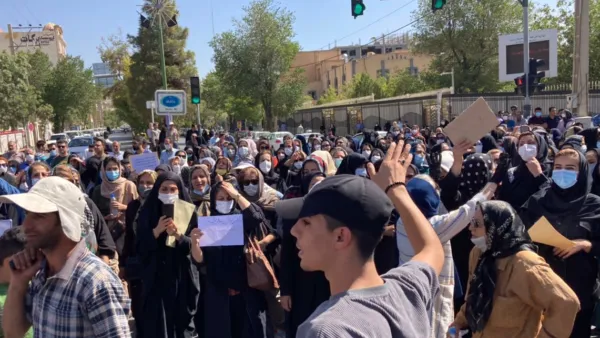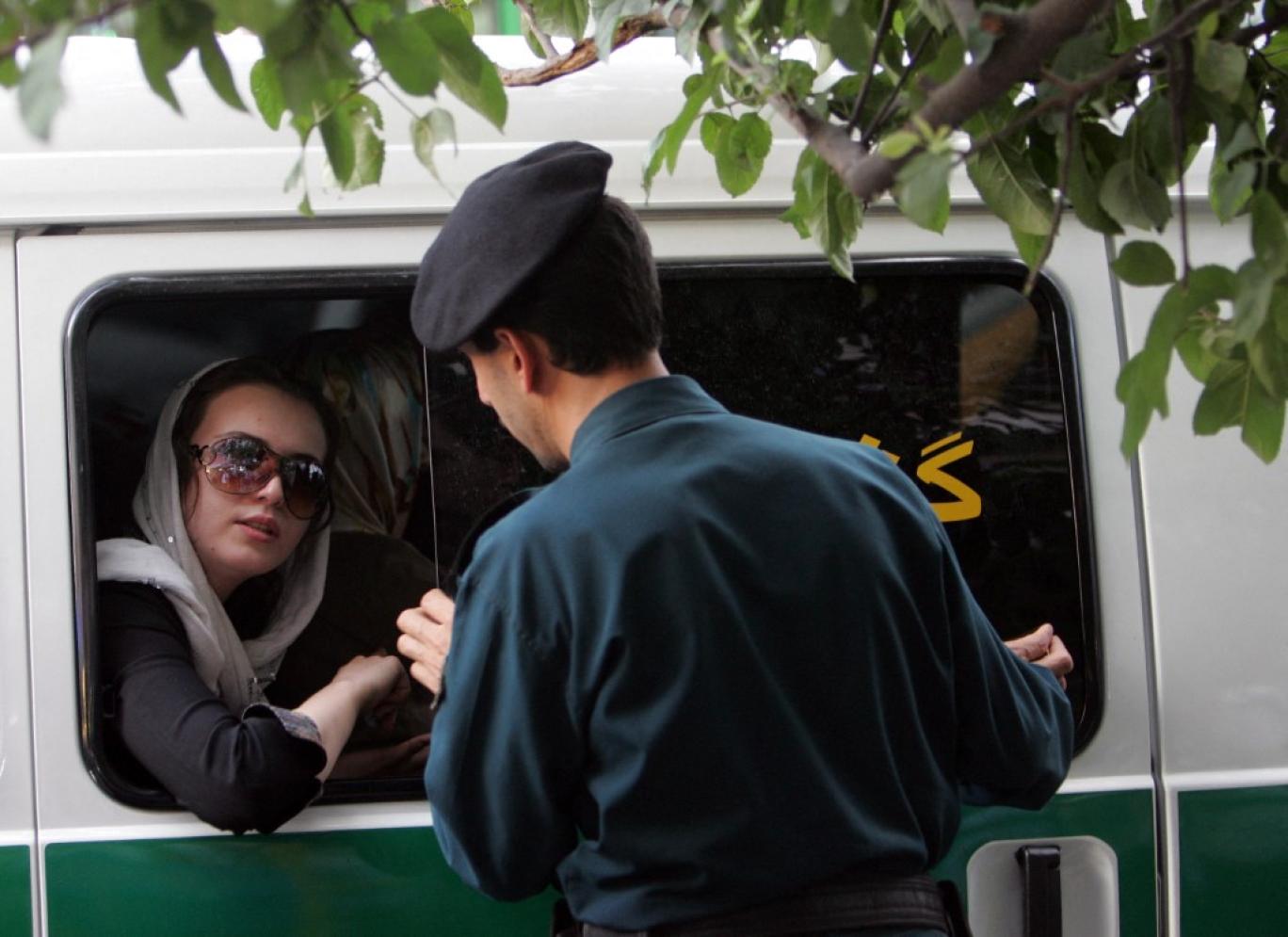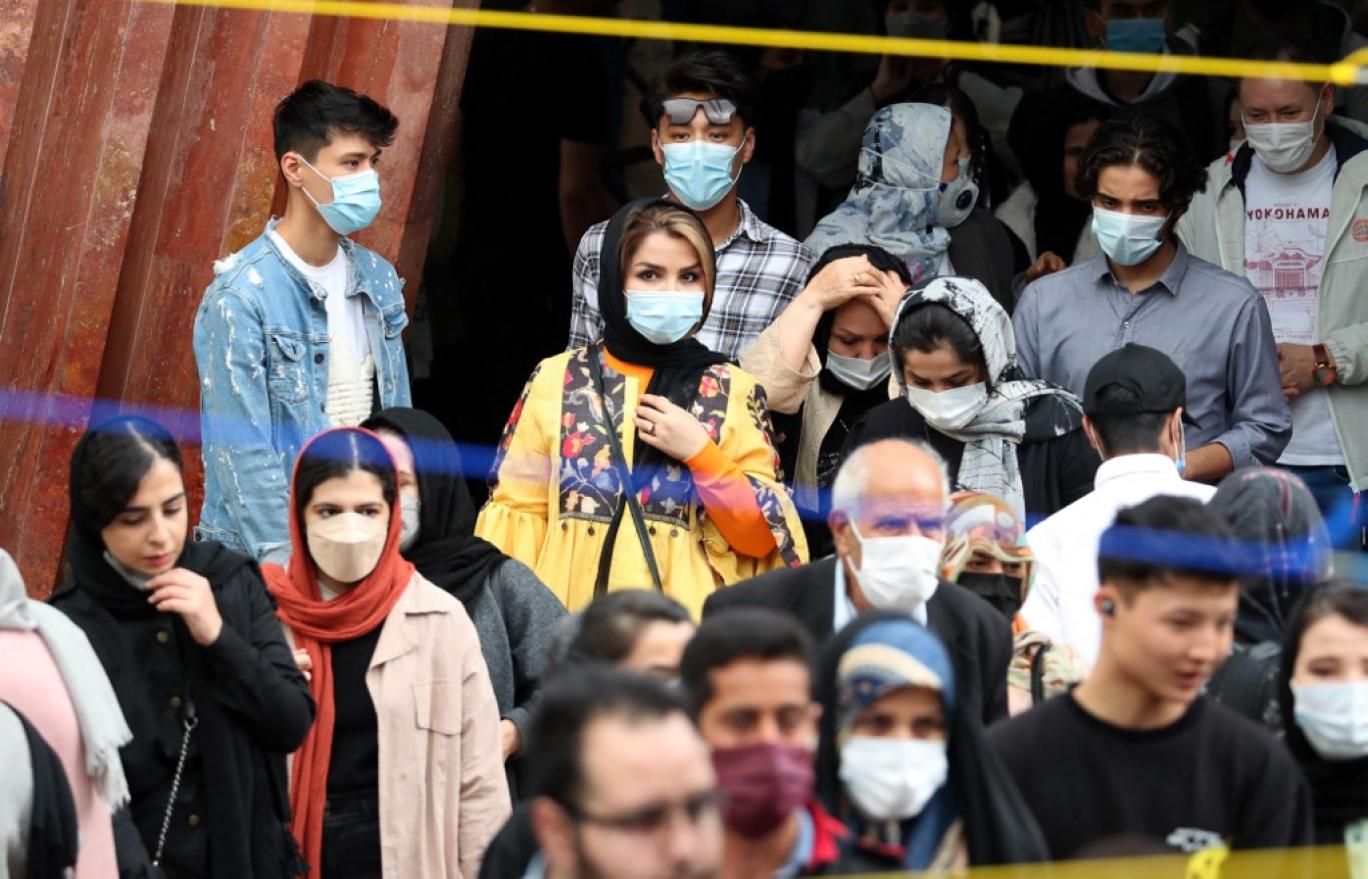
What a Predicament for the Government!
The editorial of Mardomsalari argues that Raisi’s government is in a dire predicament: it needs the backing of its “hardline” supporters who are against the nuclear deal, yet it also badly wants to revive the deal to create an opening in Iran’s deteriorating economic situation.
It is quite obvious how scared the Raisi government is about the destiny of the nuclear deal (JCPOA). His government took office while strongly criticizing the previous government, headed by Hassan Rouhani, over the nuclear talks and agreement with the West. And now that the time has come for making a real decision regarding the deal, Raisi’s government is concerned.
On the one hand, Raisi and his team know that they need the easing of US sanctions and a change in foreign policy to temporarily fix the country’s economy. Even though they claim that the impact of US sanctions has alleviated, it is obvious that the West’s pressure has cast a shadow over everything in Iran. Perhaps, there was a time when only ordinary people faced the pressure of sanctions, but now this pressure impacts sensitive issues, so a solution must be found.
But, on the other hand, the government is concerned about the reaction of its “hardline” supporters, who have always been against the JCPOA. These supporters are now waiting to see what their favorite government will do about the nuclear deal.
It has been said that the negotiators of Raisi’s government have agreed on a weaker deal compared to the one reached by the previous government, which makes it a matter of life and death for Raisi and his team. If Raisi signs an agreement to revive the JCPOA which is much weaker than the one the previous government had agreed upon, those who have been against the deal will put more pressure on his government.
Now, Ebrahim Raisi’s predicament is that he cannot let go of his “hardline” supporters, and he is also urgently needs to revive the JCPOA.
The Fallout of Educational Inequality
The editorial of Etemad, penned by “reformist” Abbas Abdi, discusses the issue of educational inequality in Iran as those students who cannot pay to go to private schools have very low chances of going to university.
Following the announcement of the results of university entrance exams this year, the following details were widely circulated about those who were accepted to go to university: 72.5 percent graduated from schools for exceptionally talented students, 22.5 percent came from non-profit schools, 2.5 percent were from exemplary public schools, and 2.5 percent were from ordinary public schools.
Many observers saw this as a clear example of educational inequality. Without a doubt, educational inequality in Iran is a much deeper problem than imagined. This situation is not the outcome of the measures of this government or the previous one; it is rather the outcome of a long process which has been going on for the past four decades.
As for the significance of educational inequality, it can be said that education is different from other basic needs of human beings. For example, we need 2,500 calories of food to live a normal life. This can be provided by cheap food. We can wear normal clothing and shoes, instead of spending money on expensive brands. And as for housing, we can live in normal homes.
But this is not the same for education. Educational inequality will damage both the individual and society. Education is not like other goods and products. It is a capital good: it is both a personal and social investment.
One of the most important resources of each country is its human resources. How can talented, creative, and competent individuals be identified? It is only possible through education. To identify these individuals, high quality education must be accessible to all.
More importantly, living in a modern society without proper education is impossible, costly, and less productive. So, just as the government uses the public budget to provide security for people, it must do the same with education as it benefits the whole of society.
Protracted Nuclear Talks and Wearied People
The editorial of Jahan Sanat argues that the prolonged nuclear talks have exhausted the Iranian people and drained their resources, suggesting that the government must resolve the nuclear issue with Western countries sooner rather than later.
Now it can be openly said that the nuclear talks have taken much too long. The fact that the nuclear talks have continued since 2001 and Ebrahim Raisi is the fourth president who is grappling with it has resulted in tragic consequences for the Iranian people. The most tragic consequence of not resolving the nuclear case is that the Iranian people are fed up with it.
Iranian citizens maintain that the nuclear program has not only put them under unprecedented economic pressure, but they have also lost trust in officials’ capabilities to resolve this issue. Experts in politics and political economy hold that governments in Iran have only two things to rely on: the country’s revenues and political and social trust.
In Iran, governments hope for revenues from exporting oil and other oil products. Now because of US sanctions, we can say that these revenues do not exist any longer and Raisi’s government cannot count on it anymore. On the other hand, given the decline in incomes, the government cannot tax people, as they very little left to give.
With eliminating subsidies allocated by the government for importing essential goods, the inflation rate has skyrocketed, and people’s purchasing power has significantly dropped. And now the government is going to put taxes on people’s property — an act which is unfeasible.
As such, protracted talks to resolve the nuclear issues have more than anything exhausted the Iranian people. Politicians and negotiators are supposed to get the best results in the worst conditions for citizens, not the worst results in the best conditions.
Iranian Officials’ Role in Promoting “Bad Hijab”
The editorial of Aftab Yazd emphasizes that the Iranian government’s policies regarding compulsory hijab for women have failed, as indicated in the rise in the number of e so-called “bad hijab women.”
These days, the issue of observing Islamic dress codes by the so-called “bad hijab women” has triggered different reactions from those who are for and against the hijab, and particularly how the confrontation by law enforcement forces against these women is considered problematic.
One of the main questions in this regard is: which age group is mainly against observing Islamic dress codes, or the so-called Islamic hijab? Why? Can Islamic dress codes be turned into a cultural value by force?
In big cities, one can easily see that the average age of those wearing the hijab improperly is not above 30. This issue is so extensive that the government has now decided to prioritize it, instead of addressing the more essential economic issues which people are facing.
Confrontation with the so-called “bad hijab women” has gone through ups and downs as governments with different political affiliations have acted differently. Whenever the so-called “reformist” governments have taken power, they have imposed less restrictions in this regard. But when the so-called “principlist,” “hardline,” ultra-conservatives have taken office, the issue of women’s hijab has been taken more seriously, and these governments have spent huge amounts of money on enforcing strict adherence to dress codes. Besides, they have also resorted to using forceful methods when confronting women.
A report released by law enforcement agencies in 2010 shows that 80 percent of those arrested for not wearing the hijab properly were between the ages of 16 to 30. They were mostly unmarried, 28 percent had higher education, and 51 percent of the families backed their children’s choice of dressing.
Although these statistics were published 12 years ago, a look at the way young people dress now shows that the methods of confrontation against women who refuse to wear the hijab properly have failed, underscoring that with such policies, they cannot ingrain their ideal dress codes into youths’ and teenagers’ minds. They must adopt a less forceful and negative method for dealing with the issue of “bad hijab.”
The increase in the number of youths and teenagers who do not follow the government’s dress codes show that the so-called defenders of the religion and culture who are in charge of coursebooks in high schools and universities have not been able to keep up with social, technological, and cultural changes. Thus, the government and authorities must re-evaluate their own policies and performance.

Several Days of Water Shortages in City of Shahrekord; Protesters Chanted Slogans Against Raisi

After nine days of water shortages in the city of Shahrekord, the center of Chaharmahal and Bakhtiari Province, protesting citizens, who have been deprived of drinking water for days, gathered in front of the governor’s office in this city and chanted slogans against Ebrahim Raisi and other officials.
Video footage released on social media shows protesters calling officials liars for not fulfilling their promises about resolving the water issues in this city.
Protesters in this assembly chanted slogans like “Death to Raisi,” “Shame on the governor,” and “Only in streets, we can claim our rights.”
Security forces were reportedly present on the scene.
Following the recent precipitation in different locations of Chaharmahal and Bakhtiari Province, the water from Kuhrang Spring, one of the main water sources for Shahrekord, became muddy and was taken out of water system.
According to IRNA news agency, as a result of this issue, there has been tension over water in seven cities and 34 villages in this province.
Meanwhile, water shortages continue in the city of Shahrekord and other cities and villages in this province, and water tankers are supplying drinking water to different regions in this province.
Chaharmahal and Bakhtiari Province has already seen multiple protests over the water crisis and the incompetent management of the government.
In May, when another round of protests in Iran started in Khuzestan Province and then spread to other provinces, protesters in the city of Shahrekord held assemblies and chanted slogans like “Death to Khamenei,” the Iranian supreme leader.
Last year, too, a number of citizens in Chaharmahal and Bakhtiari Province gathered to protest over water shortages.
The diversion of water from Chaharmahal and Bakhtiari Province to other provinces including Isfahan is another issue over which the people of this province have protested.
New Revenue for Government; Cash Fine for Women With “Bad Hijab”

Following the heightening of oppression against women and the intensification of restrictions on them, the Headquarters for Promoting Virtue and Prohibiting Vice intends to create revenues for the government through “cash fines for bad hijab.”
Mohammad Saleh Hashemi Golpayegani, secretary of the Headquarters for Promoting Virtue and Prohibiting Vice, asserted that “in the new plan for chastity and hijab, women with bad hijab are no longer criminals but violators, and will have to pay cash fines.”
Cash fines for the so-called “bad hijab women” not only makes the public sphere unsafe for women and will push them back into their homes, but will also result in economic gains for the government, particularly given the fact that there are a large of number of women who are against compulsory hijab in Iran.
According to a recent report by Hamshahri newspaper, if the morality police want to confront “bad hijab women,” they must give warnings to 15 million to 20 million people, meaning that at least 20 million women must be fined, which will add up to a huge amount of money.
The Iranian republic, despite spending a lot of money on institutionalizing compulsory hijab for women, has failed in this regard; perhaps, that is why the government intends to partially cover its expenses by fining “bad hijab women.”
The new plan for chastity and hijab warns women about releasing their own images and photos on social media, urging that they might be deprived of access to the internet for six months to a year.
But restrictions in public spaces and government offices are tougher in religious cities, including Mashhad where “bad hijab women” are banned from entering the subway.
Limitations on women in workplaces with regard to the hijab and dress codes have conspicuously increased. For example, Mellat Bank has issued a directive banning women from “wearing high heel shoes and thin stockings” and “appointing female secretaries for managers.”
Interior Minister Denies “Depression in Iranian Society,” Calls it “Enemy’s” Baseless Claims

While Iran ranks 110 among the countries of the world on the happiness index and there are multiple reports of an increase in depression and even suicide attempts, Iranian Interior Minister Ahmad Vahidi denied the existence of depression in Iranian society, calling it “wrong, meaningless, baseless words inculcated by the enemy.”
He asserted that “some make remarks about our society which, to me, are 100 percent wrong, one of which is that our society is a depressed society. These remarks are groundless and baseless.”
To prove that Iranian society is not depressed, Vahidi reasoned, “Who says our society is depressed? As soon as there is a two-day holiday, many people hit the road and we must ask the road police to control the situation.”
Vahidi continued that the biggest problem in Iranian society is drug addiction, and some organizations are trying to deal with it separately, but more NGOs must get involved in this issue to resolve it.
While the interior minister denies the existence of depression in Iranian society, the results of a study conducted in 2021 in Iran show that “out of 14,981 individuals who responded to the questions, 3,803 suffered from regular depression and severe depression, while 6,152 suffered from mild cases of depression.”
The study indicated that 6 percent of the respondents were suffering from some kind of depression, while many respondents felt sad, defeated and hopeless.
In recent months, there have been multiple reports of an increase in suicide attempts in Iran, and at least eight workers reportedly self-immolated in protest over their livelihood issues.
Although there are no official reports about the number of those who commit suicide, more than 100,000 of cases of suicide were registered in Iran in 2018 alone, according to a Health Ministry official.
Iran Claims Placing First Official Import Order With Cryptocurrency

Deputy minister of Industry, Mines and Trade said that Iran used cryptocurrency for placing an import order for the first time.
Alireza Peymanpak claimed that the first import order with cryptocurrency was worth $10 million, asserting that by the end of the summer, cryptocurrency and smart contracts will be extensively used by Iran in international trade with certain countries.
He did not state which cryptocurrency was used to place the import order and no details about the products or the seller were revealed.
Using cryptocurrencies has helped Iran in circumventing the US banking sanctions against Tehran or other sanctioned countries like Russia.
The price of cryptocurrencies, which were created in 2008 for evading the monitoring systems imposed by governments and banks over financial transactions, is vulnerable to sharp fluctuations and only poor countries like El Salvador or the Central African Republic officially use these currencies.
The United States has imposed harsh financial sanctions on Iran, making it impossible to transfer revenues from exporting oil and other petrochemical products through international banks using the dollar.
According to studies conducted last year, about 4.5 percent of the bitcoin cryptocurrency in the world was mined in Iran because of the low cost of electricity in the country.
Mining cryptocurrencies, according to Reuters, can put Iran in possession of hundreds of millions of dollars which can be used in foreign trade.
Using cryptocurrency, nevertheless, is very risky and therefore avoided in international trade.
For example, each bitcoin was priced at $81,000 in January, but in recent months its price has significantly dropped, reaching $32,000 in June and is now around $39,000.
